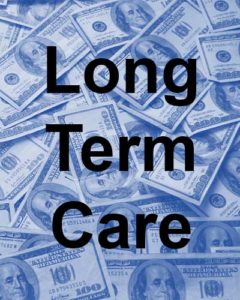Several years ago, I attended a lecture by world-renowned financial management guru Suze Orman. At one point in her talk, she asked for a show of hands of folks who had homeowners or renter’s insurance. While most hands went up in response, she assured us that few were likely to issue claims against those policies. She then asked for a show of hands of folks who had automobile insurance. Nearly all hands raised. Again, the chances that we’d need to use those policies were relatively slim. Finally, she asked for a show of hands for long term care insurance policy holders. Very few hands went up. Then she asked: Why are we spending money for policies that we’re unlikely to use while ignoring a major financial risk factor in old age?
According to Morningstar, here are a few statistics regarding long term care:
 52% of people reaching the age of 65 will need some form of long term care service in their lifetimes.
52% of people reaching the age of 65 will need some form of long term care service in their lifetimes.- Women will need an average of 2.5 years of service; men will need an average of 1.5 years of service.
- 14% of people who use long term care services will need them for 5 or more years.
- One-third of the population over 85 will need support services for Alzheimer’s disease.
- The median annual cost for services in a skilled nursing facility is $85,815 for a semi-private room and $97,455 for a private room.
As shocking as those figures may seem, they accord with my experience of parent care. My father shared a room with 3 other gentlemen in a skilled nursing facility during the last 17 months of his life. My mother resided in an assisted living facility for 3 years and has now moved into the Alzheimer’s unit. Their care costs are eye-popping!
Mercifully, my parents took out long term care insurance 20+ years ago, and both policies have rendered benefits to defray the out-of-pocket cost of care. Yet it is no small matter to file a claim and gain approval. Here were the requirements for Mom’s recent claim:
- 10-page claim form with associated 2-page narrative describing my mother’s condition
- Signed authorization form to enable the insurance company to engage directly with my mother’s care providers
- Copy of the care facility’s State-issued licensing
- Affidavit by the care provider indicating my mother’s need for assistance in performing Activities of Daily Living (e.g., bathing, dressing, eating, transferring, toileting, care for incontinence)
- Copy of my mother’s formal Plan of Care
- Results from a Mini Mental State Examination (MMSE) performed by a registered nurse or physician
- Results from a comprehensive cognitive examination signed by my mother’s primary care provider
Given the number of “moving parts” in the application process, it is no small feat to complete the package within the time frame specified by the carrier. It then takes a couple of weeks to go through the underwriting process and gain approval. Once approved, a form must be signed and submitted by the care coordinators at the end of every month to verify that services were rendered along with a copy of the associated invoice.
Even with long term care insurance, it has taken a fair amount of cash to support my parents’ care. Their policies called for self-financing of the first 90 days of care. Moreover, the care facilities want their money up-front – before they’ve provided any services. The insurance companies pay monthly claims after services have been rendered. It takes 10-15 business days to receive payment upon proper submission of the monthly form and invoice.
For example… Dad went into long term care on September 10th. His 90-day self-funded services were up in early December. But since the monthly submission could not be processed until January 1st, we did not receive any payments from his long term care claim until mid-January. Meanwhile, we were responsible for full payment of his September, October, November, December, and January fees!
Here’s the rub: You can’t wait until you are old to purchase long term care insurance. Most pundits recommend that it be secured in one’s 50s. To that end, my husband and I purchased policies years ago. They’re rather spendy, and the rates keep escalating every year. But we’re committed to maintaining the policies (or at least some fraction of our current coverage) so long as we can find the funds to support them.
One may think that the alternative of home care is far more appealing than the expense of institutional care. However, my husband and I were physically incapable of maneuvering my father to attend to his daily care needs. And my mother’s dementia is so severe that she requires round-the-clock monitoring. At a bare minimum, we’d have to have nightly staff on hand to allow us a decent night’s sleep… and that’s not cheap either! Mercifully, their astute financial management has accorded the freedom to give them the best institutional care available while keeping us healthy enough to attend to their other needs.